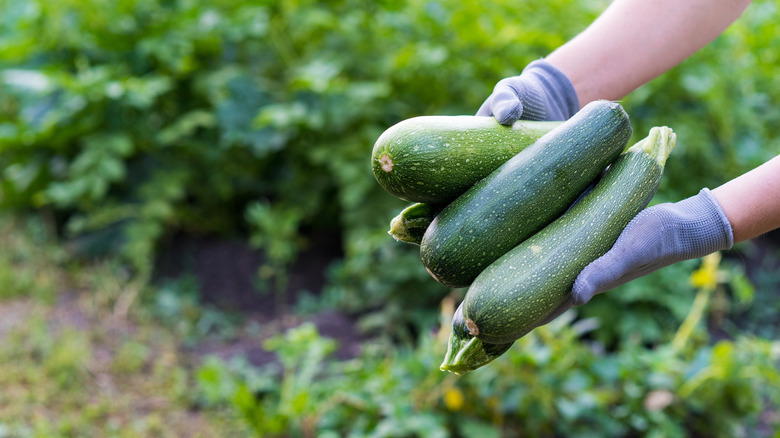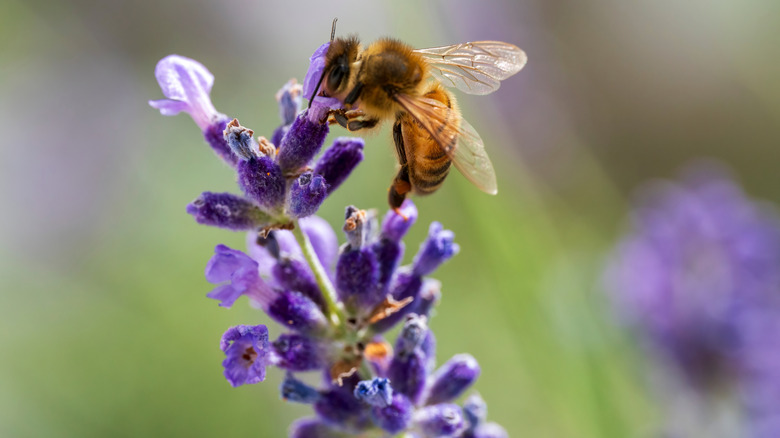This Popular Purple Plant Makes A Great Companion For Your Zucchini
Zucchini is a popular garden vegetable thanks to its fast growth, high yields, and edible blossoms. But even this resilient plant isn't immune to nature's challenges. This green gourd is a known magnet for pests like squash bugs, powdery mildew, and cucumber beetles, and once they show up, they're hard to shake. If you want to protect your zucchini without using harsh chemicals, try planting it alongside lavender. It is a time-tested companion that's often overlooked.
Lavender is more than a fragrant plant. It also works as a natural pest repellent. The plant produces natural compounds like linalool and camphor, which many insects find overwhelming or unpleasant. Adding lavender also brings more pollinators into your garden. Its tall purple flowers attract bumblebees, butterflies, and other helpful insects that zucchini plants depend on. Since zucchini flowers only bloom for a short window of time, having more bees around increases the odds of pollination and a larger harvest.
How to grow lavender near zucchini
Lavender and zucchini can grow well together, but only if you create the right conditions for both. The best way to plant lavender is to start by choosing a sunny location. Lavender needs at least six hours of direct sunlight each day, and it won't thrive in shade. Make sure the planting area receives consistent light throughout the day. Next, focus on soil type. Lavender prefers dry, well-draining soil, similar to the gravelly terrain of its Mediterranean origin. If your garden soil is heavy or holds water, you can amend it with sand to improve drainage.
Raised beds can also help keep roots from sitting in moisture, which can lead to rot. Watering should be minimal. During the first few weeks, water new lavender plants weekly until they're established. After that, lavender becomes drought tolerant and rarely needs extra watering unless you're in an extremely dry climate. English lavender (Lavandula angustifolia), in particular, grows best in USDA zones 5 through 10.
Finally, make sure your plants have enough space. Tight spacing can lead to poor airflow, which lavender doesn't tolerate well. Depending on the variety, space each plant 1 to 3 feet apart. Keep your lavender a few feet away from your zucchini to give both plants room to grow without competing for space or light.
Common zucchini companions to avoid with lavender
Not every plant that grows well with different types of zucchini is a good match for lavender. The issue comes down to differences in soil, water, and sunlight needs. While zucchini enjoys rich, moist soil, lavender thrives in dry, sandy, and well-drained conditions. Planting moisture-loving vegetables or herbs too close to lavender can stress both plants and reduce their growth.
Tomatoes are a good example. They may be good for zucchini, but they make poor neighbors for lavender. As heavy feeders, tomatoes rely on rich soil and frequent watering to produce fruit. These needs directly clash with lavender's preference for dry, low-fertility soil. In addition, tomatoes prefer slightly acidic soil, while lavender does best in neutral to slightly alkaline conditions.
In general, avoid planting lavender next to any plants that need regular watering and fertile soil, including mint and leafy ornamentals like impatiens. Instead, pair lavender with herbs that enjoy similar conditions, such as rosemary, thyme, or sage. These Mediterranean plants will thrive in the same bed without competing for water or nutrients.


